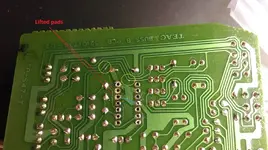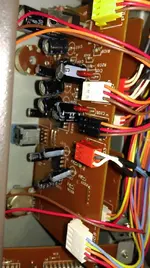famous beagle
Well-known member
I did answer it but in a roundabout way...the coarse instructions I gave for what we will do with those clip leads guided you to put everything back together after having the clip lead in place. So...the ideal would be to disassemble whatever necessary to get a lead hooked to a 'G' leg of either Q101 or Q102, and then connect everything back up and conduct the test.
So here is what you will do when you can get to it:
1. Connect a flying lead to the 'G' leg of either Q101 or Q102
2. Ensure all L-R assign switches are in the up/unlatched position
3. Power on the 388 and, with the + probe of your multimeter connected to the flying lead, and the - probe touching pin 8 of connector P102 on the BUSS B PCB (A-OK to probe the related solder joint on the M BUSS PCB), measure for DC volts
4. Latch any L-R assign switch
5. Measure for DC volts as in step 3
6. Report your measurements
I don't know exactly what voltages you should see...I'm not even sure of what state should result in positive voltage. What I DO know is Q101 and Q102 are like little gates...with voltage at a certain state at their 'G' terminals, the connectivity between their 'S' and 'D' terminals is pinched off. This is what should be happening when any L-R assign switch is latched. What I *think* is happening is the IC array U101, U102 and U104 is not functioning properly and Q101 and Q102 are always seeing the same voltage state at their 'G' terminals regardless of the state of the L-R assign switches. So rather than looking for a specific voltage in steps 3 and 5 above, we are looking to see if there is any significant *change* when any L-R switch is latched. We have tested to make sure power is getting TO U101, U102 and U104...we have tested to make sure audio is getting TO Q101 and Q102. So now we are testing to see if anything is happening at those control terminals 'G' of Q101 and Q102 when an L-R assign switch is latched. If there is little or no change between the voltage measurements at steps 3 and 5 above, that further reinforces something is wrong with the U101, U102 and U104 array, and because I have dealt with MC14069 failures on more than one occasion on a 388 in the past, my advice would be to go forward and shotgun U104.
Oh yeah, you're right, you did answer that. My bad!
Ok sounds like a plan. I'll try to get to it tonight. Thanks!

 The one on top, which is pin 6 (pin 1 is the lower left terminal in this picture), shouldn't be an issue since it's not connected to anything, correct? For the one below it ... pin 5 ... I should just be able to run a jumper wire over to pin 11, correct (see blue line)?
The one on top, which is pin 6 (pin 1 is the lower left terminal in this picture), shouldn't be an issue since it's not connected to anything, correct? For the one below it ... pin 5 ... I should just be able to run a jumper wire over to pin 11, correct (see blue line)?





